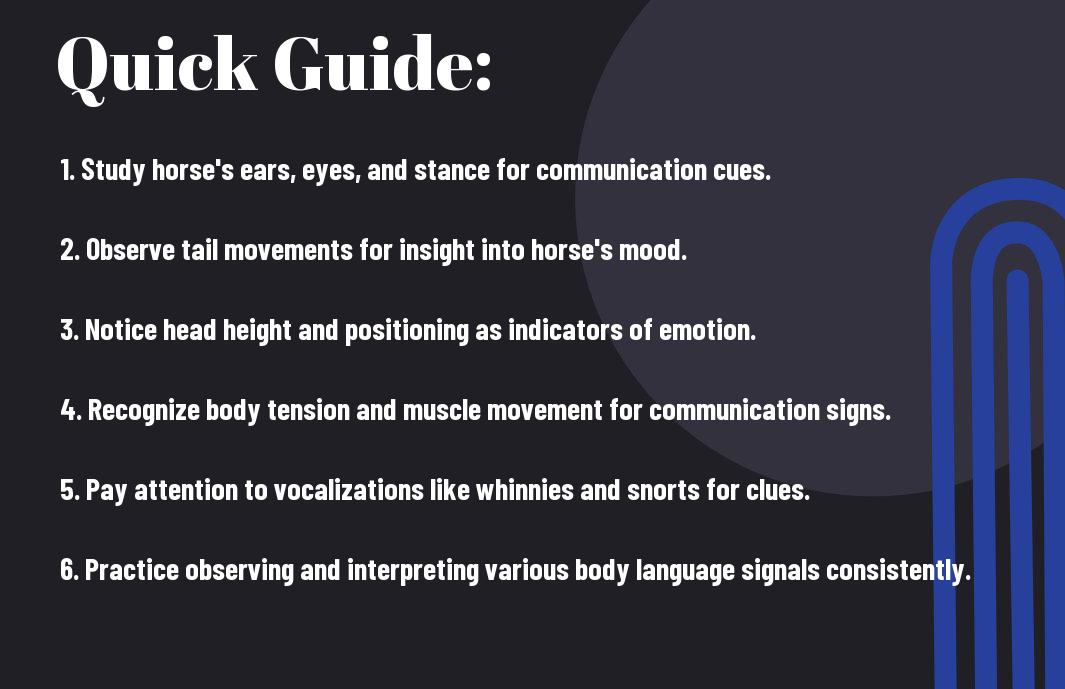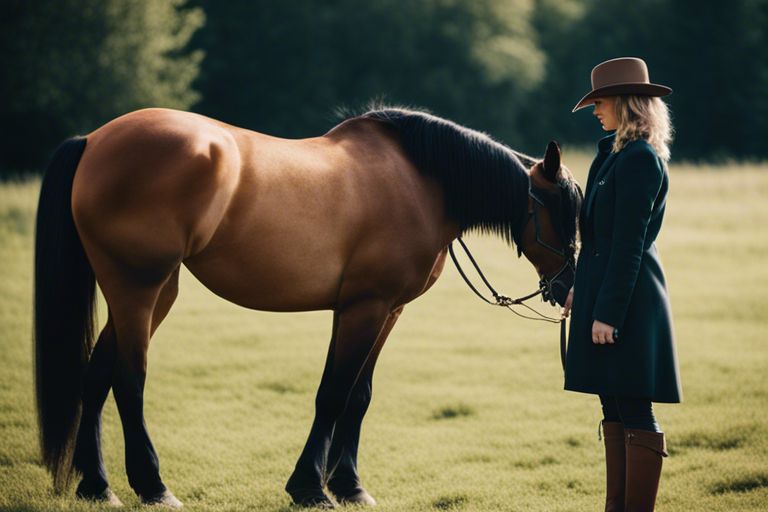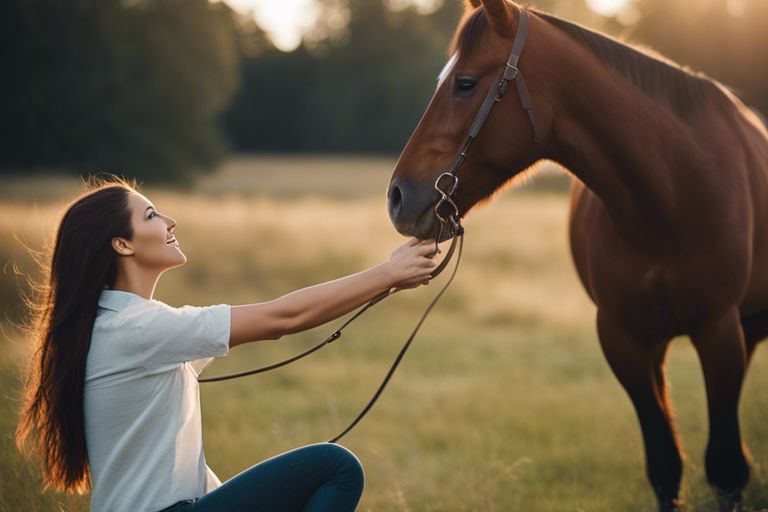Overwhelmed by the complexity of equine body language? Understanding your horse’s subtle cues is crucial for a safe and successful riding experience. In this comprehensive guide, you will learn how to interpret your horse’s signals, build trust through communication, and prevent potential accidents by being attuned to their non-verbal language. Let’s probe into the fascinating world of equine communication together!

Understanding Equine Communication
To understand equine communication, you must pay close attention to their body language. Horses communicate through a variety of signals and behaviors that can convey their emotions, intentions, and feelings. By interpreting these cues, you can better understand what your horse is trying to tell you.
Types of Equine Body Language
- Facial expressions: Horses use their ears, eyes, nostrils, and mouth to convey their emotions. For example, pinned back ears indicate aggression or fear, while relaxed ears show contentment.
- Posture and movement: The way a horse positions its body and moves can communicate dominance, submission, fear, or relaxation. A stiff stance may signal tension, while a relaxed posture indicates comfort.
- Vocalizations: Horses use whinnies, neighs, snorts, and squeals to communicate with each other and with humans. Each sound has a different meaning, such as calling for attention or expressing frustration.
- Touch: Horses may nuzzle, groom, or lean against each other or their human companions to show affection, seek comfort, or establish a bond.
- Gait: The way a horse moves can also convey information about its mood. A horse that trots energetically may be feeling playful, while a slow, plodding gait could indicate fatigue or discomfort.
Perceiving and correctly interpreting these body language cues is crucial for building a strong bond with your horse and ensuring your interactions are positive and safe.
Importance of Nonverbal Cues
Importance of paying attention to your horse’s nonverbal cues cannot be overstated. Understanding their body language can help you anticipate their reactions, address their needs, and foster a deeper sense of trust and communication.
Reading Equine Posture
Some horses might not be able to speak to you in words, but they communicate a great deal through their body language. Understanding equine posture can provide you with valuable insights into what your horse is feeling or thinking at any given moment.
Ear Position and Its Meaning
Little movements and positions of your horse’s ears can tell you a lot about their mood. **Forward-pointing ears signal alertness and interest**, indicating that your horse is focused on something in front of them. On the other hand, **ears pinned flat back against the head can signify aggression or irritation**, a sign that you should approach with caution.
Tail Swishing and Its Significance
Any **repetitive swishing of the tail can indicate discomfort or annoyance** in your horse. This behavior could be a response to flies, a poorly fitting saddle, or even pain. It’s crucial to investigate the underlying cause if you notice frequent tail swishing to ensure your horse’s well-being.
**Recall, a flicking tail during grooming or riding may also signify impatience or resistance**. Understanding the context in which your horse displays this behavior will help you address any issues and improve your bond with them.
Head Position and Facial Expressions
Swishing your horse’s tail from side to side could be a sign of agitation or discomfort. **Take note of the intensity and frequency of tail swishing to determine the level of distress your horse may be experiencing**.
**Facial expressions, such as wide eyes and tense muscles around the mouth, can also indicate fear or anxiety**. Pay attention to these subtle cues to better understand your horse’s emotional state and respond accordingly to ensure their well-being.

Identifying Emotional States
For a horse owner or enthusiast, being able to read your horse’s body language can provide valuable insights into their emotional state. By understanding the cues they give off, you can better respond to their needs and ensure a positive and safe interaction.
Recognizing Fear and Anxiety
If your horse is experiencing fear or anxiety, they may exhibit signs such as wide eyes, raised head, tense muscles, pinned back ears, and a tendency to flee. It’s imperative to approach a fearful horse with caution and give them space to assess the situation without feeling threatened.
Identifying Aggression and Dominance
While aggression and dominance can sometimes be displayed by a horse through behaviors like pinned ears, bared teeth, stomping, or charging, it’s crucial to differentiate between the two. Aggression is more about intent to harm, while dominance is about establishing hierarchy within their herd or with humans.
To address aggression or dominance in a horse, you must establish yourself as the leader through consistent training and clear communication. It’s imperative to set boundaries and enforce them to ensure both your safety and the well-being of your horse.
Understanding Submission and Relaxation
With submission and relaxation, a horse will display signs such as lowered head, relaxed ears, soft eyes, licking and chewing, and a willingness to follow your cues. These behaviors indicate that your horse feels safe and trusts you as their leader.
Identifying submission and relaxation in your horse is a positive sign that your bond is strengthening, and they are comfortable in your presence. Encouraging and rewarding these behaviors can help build a strong and trusting relationship with your horse.

Factors Affecting Equine Body Language
All equestrians need to understand that several factors can influence equine body language. By being aware of these elements, you can better interpret what your horse is trying to communicate to you.
Breed-Specific Traits and Characteristics
Regardless of the breed, horses have certain characteristic traits that can influence their body language. Some breeds are known for being more expressive or reactive, while others may have a calmer demeanor. Recognizing these differences can help you understand how your horse typically behaves in various situations.
Environmental Influences and Context
To understand equine body language fully, you must consider the environmental influences and context in which your horse is displaying certain behaviors. Factors such as the surroundings, temperature, and other animals nearby can all impact how your horse communicates with you.
Body language that may indicate stress in one setting could simply be excitement in another. Observing your horse in various situations will help you understand how different environments can influence their behavior.
Individual Personality and Temperament
Each horse has its own personality and temperament, which greatly impact their body language. Some horses may be naturally more anxious or cautious, while others are confident and curious. Understanding your horse‘s individual characteristics will help you interpret their signals more effectively.
The more you work with your horse and observe their behaviors, the better you will understand their personality and how it impacts their body language. By recognizing your horse‘s individuality, you can build a stronger bond based on trust and mutual understanding.
Tips for Effective Communication
Once again, understanding your horse’s body language is crucial for effective communication. By paying attention to signals such as ear position, tail movement, and body posture, you can better interpret what your horse is trying to communicate.
- Building Trust and Establishing a Connection: An important aspect of effective communication with your horse is building trust and establishing a connection. Spend time with your horse building a relationship based on mutual respect and understanding. This will help your horse feel more comfortable around you and lead to better communication.
Building Trust and Establishing a Connection
An important aspect of effective communication with your horse is building trust and establishing a connection. Spend time with your horse building a relationship based on mutual respect and understanding. This will help your horse feel more comfortable around you and lead to better communication.
Avoiding Misinterpretation and Miscommunication
There’s a possibility of misinterpreting your horse’s body language if you are not attentive enough. Miscommunication can occur when you misread the subtle cues your horse is giving you. Pay close attention to your horse’s expressions and movements to avoid misunderstandings.
Establishing a clear and consistent means of communication with your horse is crucial for a strong partnership. Miscommunication can lead to frustration and potential safety hazards. By understanding your horse’s cues and responding appropriately, you can build a bond based on trust and respect.
Using Positive Reinforcement Techniques
For effective communication with your horse, using positive reinforcement techniques can be highly beneficial. Rewarding your horse for desired behaviors encourages them to repeat those actions. This positive approach creates a harmonious environment for learning and understanding between you and your horse.
Building a relationship based on positive reinforcement fosters a sense of trust and partnership between you and your horse. By rewarding good behavior, you encourage your horse to feel confident and comfortable in their interactions with you.
Step-by-Step Guide to Reading Equine Body Language
Not being able to communicate verbally, horses rely heavily on their body language to convey their feelings, moods, and intentions. Understanding equine body language is crucial for building a strong bond with your horse and ensuring safe interactions. Here is a detailed guide on how to read and interpret your horse’s body language:
Observing from a Distance
| Body Part | Signs to Look For |
| Head | Alert ears, wide eyes, licking lips |
| Body | Tense muscles, raised or lowered head, tail swishing |
If you are observing horses from a distance, pay attention to their body language cues from afar. **Body** language can provide valuable insights into the horse’s state of mind and help you determine whether it is safe to approach them.
Approaching and Interacting with Horses
| Approach | Interpretation |
| Approaching with a relaxed posture | The horse may be more receptive and calm. |
| Approaching with direct eye contact | The horse may perceive it as a threat or challenge. |
If you are **approaching** a horse, it is necessary to do so with caution and an understanding of their body language. Making yourself appear non-threatening and being aware of their responses can help establish a positive interaction.
Distance: Maintaining an appropriate distance from the horse is crucial. Invading their personal space may lead to discomfort or aggression, while staying too far away may hinder bonding and communication.
Responding to Equine Cues and Signals
| Cue or Signal | Proper Response |
| Backing away or ears pinned back | Give the horse space and reassess your approach. |
| Relaxed posture, ears forward | Continue interaction in a calm and gentle manner. |
You should **respond** to the cues and signals your horse is giving you promptly and appropriately. Ignoring or misinterpreting these signals can lead to misunderstandings and potentially dangerous situations.
With: With practice and patience, you will develop a deeper understanding of your horse’s body language and be able to communicate effectively with them using non-verbal cues.

Pros and Cons of Understanding Equine Body Language
Your ability to understand equine body language can have a significant impact on the welfare and safety of your horse. Here is a breakdown of the pros and cons of honing this skill:
| Benefits | Limitations |
| Enhanced communication with your horse | Interpreting body language can be complex and nuanced |
| Early detection of health issues or discomfort | Incorrect interpretation may lead to misunderstandings or mishandling |
| Improving the overall relationship and bond with your horse | Not all horses express themselves in the same way |
| Increased safety when handling or riding your horse | Requires continuous practice and observation |
Benefits for Horse Welfare and Safety
Equine body language is a valuable tool that can help you ensure the well-being and security of your horse. By being attuned to your horse’s expressions, posture, and movements, you can detect signs of discomfort or distress early on. This proactive approach allows you to address any potential issues promptly, promoting your horse’s physical and emotional welfare.
Limitations and Potential Pitfalls
While understanding equine body language is incredibly beneficial, it comes with its own set of challenges. Interpreting signals accurately requires a deep understanding of your individual horse’s behavior. Not all horses communicate in the same way, and mistaken interpretations can lead to miscommunication or mishandling.
It’s necessary to keep in mind that misreading your horse’s cues can have serious consequences, potentially putting both your safety and your horse’s well-being at risk. Therefore, while developing your skills in interpreting equine body language, always seek guidance from experienced professionals and continue learning to refine your understanding.
Final Words
So, understanding equine body language is crucial for any horse owner or handler. By being able to interpret your horse’s signals, you can better understand their emotions, reactions, and needs. This knowledge can help you build a stronger bond with your horse, making it easier to communicate effectively and ensure their wellbeing. Remember to observe your horse closely, pay attention to their ears, eyes, mouth, and body posture to gain insight into their feelings and intentions. With time and practice, you will become more adept at reading your horse’s body language and fostering a deeper connection with them.
Q: What are some common signs of a relaxed horse?
A: Some common signs of a relaxed horse include a relaxed stance with weight evenly distributed on all four legs, relaxed ears pointed slightly to the side, soft eyes, and a gently swaying tail.
Q: How can I tell if a horse is agitated or stressed?
A: Signs of an agitated or stressed horse may include pinned ears, wide eyes with visible whites, flared nostrils, teeth grinding, tail swishing forcefully, and a tense overall body posture.
Q: What does it mean when a horse yawns?
A: A horse yawning can indicate that they are either physically tired or trying to release tension. It can also be a sign of relaxation, especially after a stressful situation.
Q: How can I interpret a horse’s tail movements?
A: A horse’s tail movements can convey different emotions. For example, a relaxed and content horse may have a gently swaying tail, while a horse that is agitated or annoyed may swish its tail forcefully or hold it rigidly.
What does it mean when a horse licks and chews?
A: When a horse licks and chews, it is often a sign of relaxation and submission. This behavior can indicate that the horse is processing information, feeling more comfortable in a situation, or showing signs of submission to a higher-ranking horse or human.











